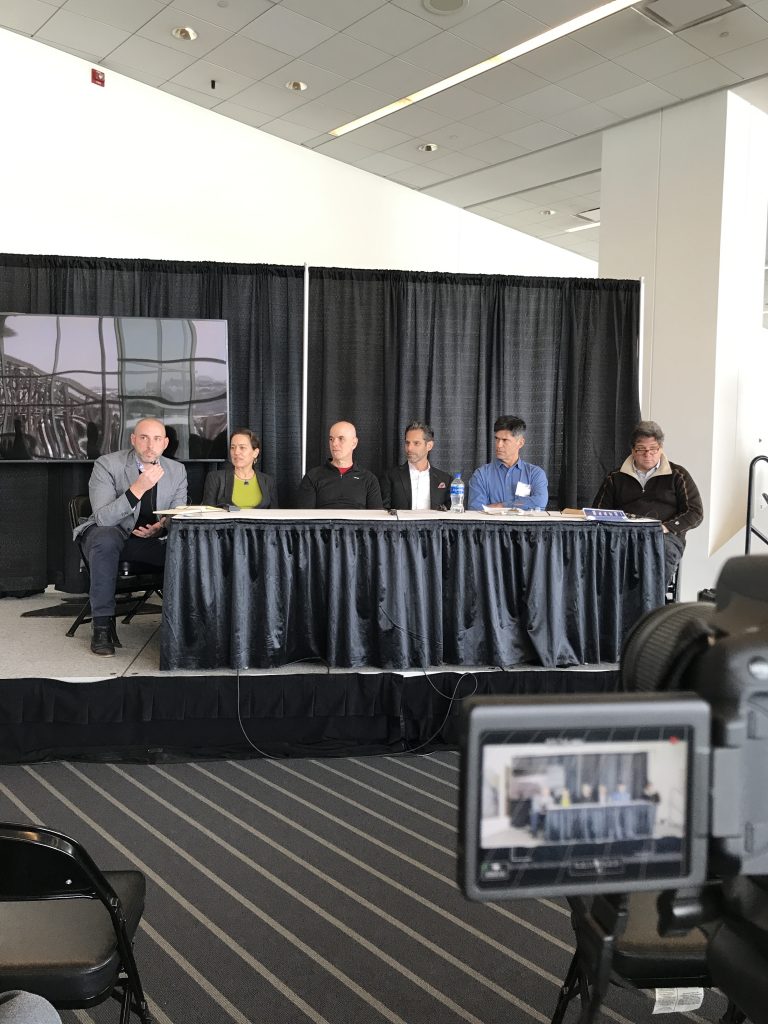Local Architects Present at Home and Garden Show 2022
A Panel on Residential Architecture:
Brought to you by AIA Pittsburgh “Blueprint 4 Better”
By Bea Spolidoro, AIA, WELL AP, 2022 President of AIA Pittsburgh

The panelist of the AIA Pittsburgh “Blueprint for Better” panel on residential architecture
Parts of our City and region are undergoing rapid physical change. There is an urgency to be thoughtful and strategic about the impact that new development and design choices can have on the health and well-being of our communities and residents. What we choose to build today will shape greater Pittsburgh for the next half century.
The way a space is designed is constantly influencing how we feel physically, emotionally, and psychologically. Buildings are never neutral. Since January 2020, the total construction spending for residential in the United States has grown by almost 29%. Architects ought to support the creation of better, more sustainable, and healthier homes.
This panel brought together Mary Cerrone, of Cerrone Architecture + Design; Jeffrey DeNinno, AIA of DeNINNO Architects; Eric Fisher, AIA of Fisher ARCHitecture; Peter Margittai, AIA of Margittai Architects; and Bob Shelton, AIA of Shelton Design/Build (Moderator).
Here is a 10-minutes video, capturing some big ideas as shared on stage.
Mary Cerrone: The Value of hiring an Architect
Mary reminded attendees of the benefits of working with an architect, either before buying a home, or while renovating an existing one. After clarifying that architects are NOT home inspectors, Mary highlighted how architects are true advocates for the homeowners. Architects notice the pros and cons of existing buildings and may save potential buyers lots of money – and future headaches! – by warning clients about challenges down the road.
She also spoke about the many ways people can work with architects, from hiring us for limited services – such as Schematic Design layouts only – to hiring us for full services. She walked through the various design phases (Schematic Design, Design Development, Construction Documents and Construction Administration) illustrating the kind of support homeowners may need. She noted how construction can be an overwhelming process and that an architect “speaks contractor” and can field many questions when construction starts.
Freddie Croce: Healthy, Sustainable Homes
Freddie reminded everybody how sustainability is first of all a mindset. Architects can support homeowners interested in living more sustainably by evaluating the available options and products. Because the total of all buildings consumes ⅔ of energy in the world, architects have the opportunity to make a difference in the industry by guiding clients towards a more sustainable project outcome.
Architects can help clients in forming a “sustainable strategy” by taking note of goals, expectations, and budgets. Sustainability is always a tradeoff between many options and architects can help prioritizing.
While building codes offer minimum sustainability standards, architects can deepen the conversation. And while many elements of good, healthy, sustainable design are not seen, they are fundamental to complete projects successfully. This is one way architects improve people’s lives through the built environment.
Bob Shelton added that, even if some money is put into “invisible” yet sustainable features, it is important to explain the story behind every design choice. In the end, he says, clients appreciate and understand the difference.
Jeff DeNinno: Accessibility and Aging in Place
Jeff spoke about how architects can support people that would like to keep living in their home for as long as possible. Starting from adding or remodeling bathrooms on the first floor, Jeff gave us a “virtual tour” of the ideal home, suited for aging in place.
He reminded the attendees that there are many things to keep in mind, when making a space more accessible. From kitchens with easy-to-operate controls, to showers big enough to accommodate helpers, to elevators: Architects can help people in reinventing existing homes.
He touched on the difference between a fully accessible home, and a home that can be designed to be made accessible in the future. Once again, architects can support homeowners in making better decisions early on, setting them up for success in the future.
Bob Shelton reminded how architects should always design with empathy. This is true not only when designing sustainable homes, but in every building typology.
Eric Fisher: The Architecture Quality
For Eric, “Architecture Quality” is about the attitude towards the projects and the process of architecture. He reminded us to be good listeners, but also a bit of psychologists, as we interpret the needs and the wants of our clients.
To stay creatively “fresh”, he suggested architects should be risk takers, but also educators. In Eric’s words: Some people may end up listening to you! This way, every project will be different and possibly better than every previous project.
This will help architects in achieving something very important: Loving what we do. This is important to keep in mind, because a project that is designed with passion will be successful on many fronts.
Last but not least, as we “design the world” that the next gen will inhabit, it is important to take our time to design it thoughtfully. Eric reminds us to stop, and think carefully, as we develop our projects.
Peter Margittai: Renovating Homes in an Historic City
Peter reminded us of how Pittsburgh has lost 55% of its population since the 1950s. Every day there is the opportunity to work on home renovations that feature fascinating details, solid materials – if properly maintained – and a craftsmanship that is long gone. Moreover, many historic buildings are in old neighborhoods that are charming, walkable, and foster a sense of community.
Homeowners that want to renovate an old home may need help from an architect in resolving antiquated home layouts, or odd additions. Peter noted how there are really only so many “types” of old homes in Pittsburgh. A skilled architect, familiar with renovating old homes, can help homeowners in reinventing their homes in efficient ways.
He recommended the attendees to find a good fit for their project: Both a good architect and a good contractor with experience in renovating old homes. While renovations, in general, are not for the faint of heart, hiring an architect is a great way to figure out the unknowns, and to navigate the inevitably bumpy road of dealing with an historic building.




